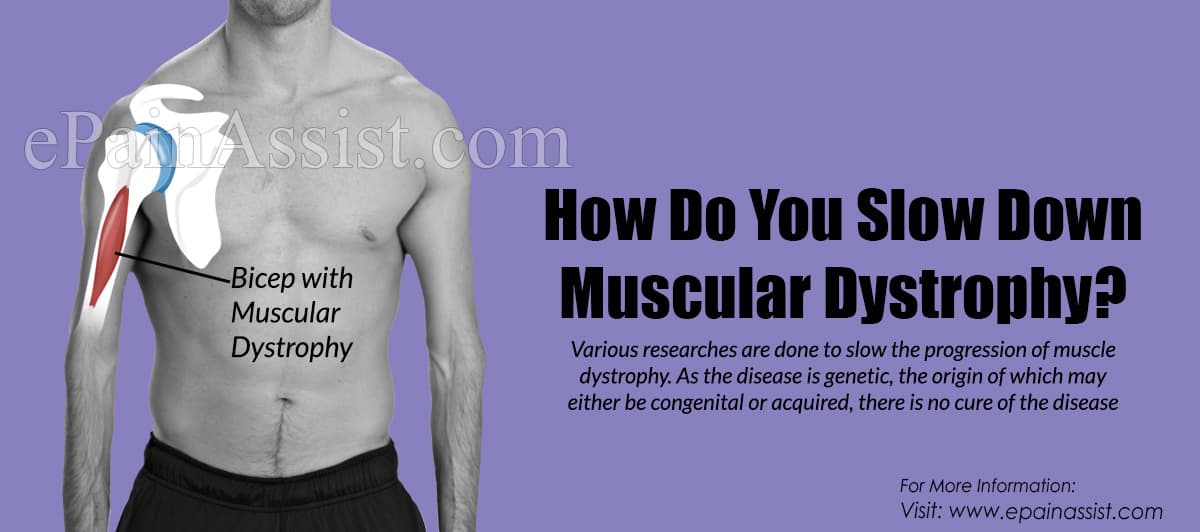Muscular dystrophy is a genetic disease and there is presently no cure available for this disease.1 Thus, the approach for the treatment is to slow the progression of the disease and to improve the quality of life of the patients.

How Do You Slow Down Muscular Dystrophy?
Various researches are done to slow the progression of muscle dystrophy. As the disease is genetic, the origin of which may either be congenital or acquired, there is no cure of the disease.1 Although, the gene therapy has shown some promising results, but the gene therapy is in very nascent stage and a lot of work is to be done in this particular therapy to make it available to the patients. Thus, in absence of any curative therapy, the whole focus is thus shifted on slowing down the disease, improving the patient’s quality of life and increasing the life span of the patients. Following are the measures adopted for slowing the progression of disease:
- Steroids: Steroids such as prednisone and deflazacort are used to slow down the progression of the disease by inhibiting the production of inflammatory mediators and the action of macrophages but in the long run they have their own side effects.2 Research is going on to identify the derivatives of the steroids which have lesser side effects with greater or at least similar efficacy.
- Estrogen Modulators: A recent study has concluded that the estrogen modulators tamoxifen and raloxifene have shown positive results in slowing the progression of muscular dystrophy. They have also shown to improve the function of cardiovascular system and respiratory system in the patients with muscular dystrophy. Improved muscular function and increased bone density are also shown by these agents.
- Immunosuppressive Drugs: Immunosuppressive drugs such as cyclosporine suppresses the immune system, thus the cells of the immune system are not able to act against the muscles. Thus, the muscle wasting is slowed, and the progression of the disease is delayed.
- Dietary Supplements: Although dietary supplements do not directly involve in slowing the progression of the disease but plays an important role in reducing the oxidative stress of the body thereby preventing further damage from the free radicals. Muscle wastage is a complex process involving muscle rupture and action of macrophages leading to production of free radicals. Thus, antioxidants such as resveratrol or ubiquinol can be administered to the patient suffering from muscular dystrophy.
- Peptide Therapy: Peptide therapy is also under the clinical trials and is believed to slow the progression of the disease. Peptide therapy reduces the damage of muscles and also helps in preventing the effects of mediators involved in such processes.
- TAS-205: Presently under clinical trial, this molecule has shown promising results in slowing the progression of muscular dystrophy. There is an enzyme called hematopoietic prostaglandin D2 synthase, that plays a crucial role in the damage of the muscle cells. This molecule, TAS-205, inhibits this enzyme and helps delaying the progression of muscular dystrophy.
- Exercises: Some exercises also prove to slow the progression of the muscular dystrophy. These exercises include aerobic exercise, strength exercises and stretching. Aerobic exercise is prominently used to increase the function of the heart, and low-impact aerobic exercises are helpful. Strength exercise helps in improving muscle tone and keep the muscles healthy. In muscular dystrophy, dystrophin is absent which is responsible for providing stretching ability to muscles, thus stretching the muscles during exercise reduces the muscle stiffness.
- Idebenone: This medication is used to reduce the life-threatening complications of muscular dystrophy. Study concludes that idebenone helps in slowing the decline of respiratory process. The fatality due to muscular dystrophy is through cardiac and respiratory complications.
- Cardiac Drugs: Cardiac muscles, if affected by muscular dystrophy, results in fatal consequences. Thus, to increase the life of the patient and help in increasing the efficacy of heart, cardiac drugs are administered to the patients. These drugs include beta blockers and angiotensin receptor antagonists.
Conclusion
Various options are disclosed in the literatures which can be used to slow the progression of muscular dystrophy. Some are available for patient’s use while others are under the clinical trial. The drugs include steroids, immunosuppressants, cardiac drugs and TAS-205 for slowing the progression of the disease.
Also Read:
